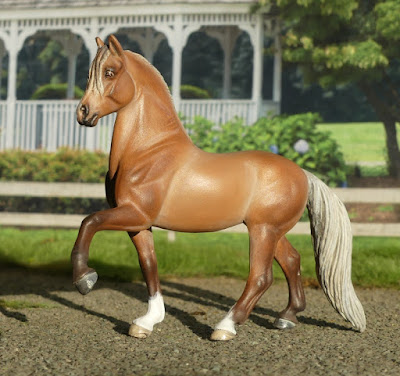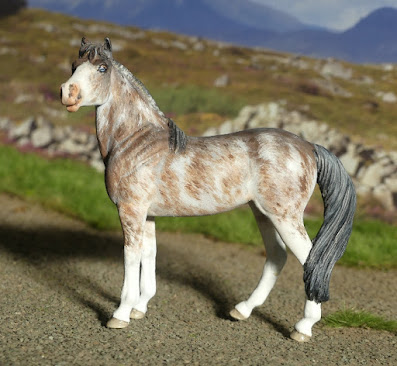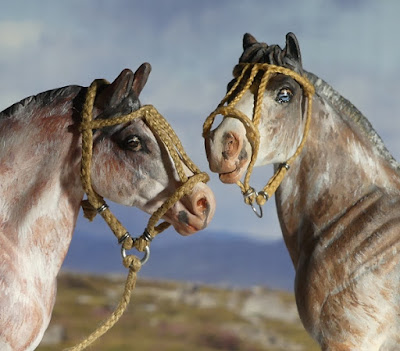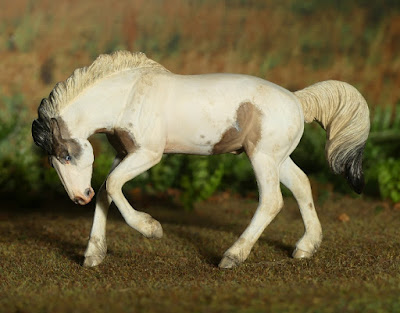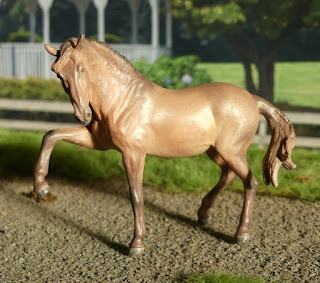Sunday 31 January 2021
Tales from the Body Box - South American Special!
Monday 25 January 2021
Tales from the Body Box - Wee Wyakin
One of the things which must feel familiar to most people who paint model horses is the guilt that comes with having long-unpainted bodies. You know the ones. You really, really wanted them at the time - a fantastic example of your absolute favourite breed, or one you'd always wanted and never had chance to buy before? Maybe you took pity on a damaged horse, or fell for the real-life backstory behind a resin, and couldn't resist. Or perhaps they were in a charity sale and your heart was behind the cause.
The International Blessed Broodmare Project was that worthy cause for a lot of collectors - over a decade ago now the hobby pulled together to help rehome hundreds of horses from the defunct PMU industry, by supporting the dedicated work of Animali Farm. Mostly mares, many pregnant, their plight struck home for our community of horse lovers, with money desperately needed to pay medical testing and shipping fees so the horses could be adopted into caring new homes before they were sold for slaughter.
Artists painted donation models, sculptors sold their own unpainted resins, there were live show raffles, online auctions, fundraiser shows, and all sorts. I remember running a photo show and when I sent in the total raised, told them simply 'put it toward whichever horse you think needs it most', and received a lovely email some time later telling me our money had gone toward homing the piebald draft stallion, King.
The other day, I picked out a half forgotten, wholly neglected horse from my hidden stash of resin bodies : Wee Wyakin, by Michelle Platt. But didn't remember the circumstances of buying her til I checked my notebook, where beside her name, I'd scribbled down 'TIBBP charity model'.
I think, and I'm not too sure after all this time, that she may have come over direct from America (I know my big Aalef resin, by the same sculptor, was also a TIBBP purchase), though it's possible from the vagueness of my note that someone here in the UK sold or auctioned her for the charity.
Either way, she'd come to join my herd, and raised a bit of money toward the PMU mares on her way here.
And here's where the guilt comes in.
Despite loving the resin, I'd tucked her away safely to paint 'later' because she was a little big when I only felt up to tackling Stablemates, and then for a long while, I didn't feel like painting any models at all.
So she gathered dust. A whole thick fuzzy coat of 10 years' worth of it all down one side. So many colourful Wee Wyakins out being enjoyed in the world, and one blank one being ignored, patiently waiting for her paint.
Well, she doesn't have to wait any longer, here at last I can introduce Mishawaka, the long lost copy of dear little Wee Wyakin!
I love how she turned out - there's a long delayed satisfaction in having wanted her so much at the time, and liking her so much now she's done. Welcome to the herd, Mishawaka!
Sunday 17 January 2021
Tales from the Body Box - Mustangs
One of the things I find most fascinating about the model horse hobby is how it can spark interest in real horse breeds from all over the world, which we might never have had any contact with in person, and never knew much about. I often find myself reading up on breeds to research possible colours to paint, or correct naming traditions, or even just to satisfy the curiosity to find out more about a breed I just bought a model of.
Last week, I emptied all the Stablemate bodies from my box and laid them out to see what I'd got left - any multiples of the same mould in there? Hmm, yes, there's several of the G4 ('rivet') mustang, let's have a mustang for a change. Better check if there's any colours I mustn't put on these...
Five hours later, I'm still oohing and ahhing over photos of mustangs in all kinds of colours, having read page after page by owners and enthusiasts, learnt a lot about the history of the breed and the strains with their differing characteristics, and I feel like I can add the mustang to the list of breeds I've never met but know a decent amount about.
Oh, and by the way, if you want a truly heartwarming horse story with a happy end (and who doesn't!), check out this Youtube video about Phoenix - and there's more about him, and all his herdmates, here.
So, feeling thoroughly primed by all these photos, I picked up the first mustang SM and started filing away the logo and seams, and considering colour options.
I've already done this mould in dark bay, wild bay, bay tobiano, and yellow dun; and while the blacks, greys & chestnuts are handsome, those are colours I've painted many times over on other moulds already, so the mustangs which stood out to try next were the roans, the more unusual pintos, and the various spotted patterns.
I mentioned in my last blog post that high on my little to-do list of coat colours I haven't painted before was a medicine hat pinto, so this seemed an ideal breed to carry that pattern, and I chose a grulla colour for the patches.
It's much more fiddly this way round, and getting the shading applied while staying 'inside the lines' is incredibly tricky. I had to use diluted paint dabbled on in thin loose layers a bit like watercolours, which really goes against the grain when I'm more of a smudgey, dry-brushing, thick-paint-in-thin-layers painter, but for a one-off technique improvised to achieve this pattern, it kind of worked!
The dark patch on his off side hock there is just shadow, not a marking, you can see in the next photo it's not really there.
This mould has really grown on me over the years, when I first saw it in the promo photos it looked very awkward and uncomfortable, almost a broken-backed pose, but real horses captured in motion do have some really gawky-looking phases in their gaits or movements, especially when bucking, squabbling, or larking about - and it's fine to have models which aren't doing perfect textbook poses!
Of course, while I was in a mustangy mood, I decided this boy needed a companion, so I went for another colour I'd admired in the real ones, a little like the now-famous Phoenix linked further up this post, but copied from this random Google Images photo I can't find an original source for - I liked the bigger blanket pattern, and the fact he's a slightly darker colour so my white paint would stand out more visibly.
I haven't managed to name either of these yet - I kind of feel they should have nature-based names as a nod to the wild outdoor life of their breed, but don't know anything about the native plants, trees, or wild birds of any home areas for the mustang herds, so that's more research to be done at some point!
Monday 4 January 2021
Tales from the Body Box - New year, new colours!
A recent discussion with some Julip fans about what colours we'd got, and especially what colours were missing from our collections, made me wonder the same for the colours I'd painted. After last year's shock realisation that I'd never done red dun or cremello customs, were there other obvious gaps I really should have filled by now? So I dug the colours chart back out, and started ticking off the ones I've already painted at least once.
What's left stands out as a Never Painted list of colours I'd somehow never thought of, or avoided because I preferred other variations on the same theme, and this year I'm determined to fill some of those gaps.
The list contains four kinds of appaloosa, because surprisingly in all this time I've only ever painted blanket spotted, leopard or semi-leopard, or a sort of extended blanket varnish roan combination of spots on top of mottled colour. I decided to tackle snowflake first from my missing ones, a pretty colour which I'd deliberately never tried cos I feared it'd look too much like white paint spattered over a perfectly good paintjob!
So instead of risking the paint-spatter technique, I decided to go with a much more controlled application of white, got out one of my tiniest brushes, and applied the spots and roaning carefully by hand. It took ages, but I think the results are worth it!
Of course, as usual when researching a colour, I was then in the middle of an appaloosa mood, and the very next custom ticked off another of the missing patterns - snowcap appaloosa, a blanket without the usual spots inside it. It's not that I don't like this colour on real horses, I just enjoy painting the spots on model ones, so I'd never done the appaloosa types which don't have any spotting!


A couple more angles, just because he's not quite the same on both sides, and the light helps bring out the detailing of his face. I've named him Snow Angel, to suit both the name of his colour, and the time of year (we had snow in December, my horse makes snow angels by rolling in multiple spots all over the field).
Another notable gap in my herd of customs was Pearl. A relatively recently identified dilution gene, which only really came to light many years after I'd already learnt about horse colours and started painting them, so I suppose I didn't see it as 'missing' cos it never was in my mind to start with!
Most famous in Iberian breeds, I dithered between using up one of the G2 Andalusians which've been in my body box for ages, or picking the much newer Spanish Walk Andalusian, in the end the more exciting choice won!
The pearl dilution works by altering base colours, but it's more complicated than usual. One pearl gene, and the horse's colour isn't changed, it'll just look bay or chestnut or whatever. Two pearl genes, and you get the pearl colouration. But here's the thing - cream can also work as a 'second' pearl gene, so a horse carrying one cream gene and one pearl, will come out with paler variations of the pearl colour.
I went for one of the more basic options, bay plus two pearl genes, creating a colour known as brown pearl, and have named him Valenciano.









